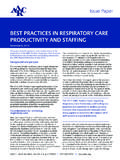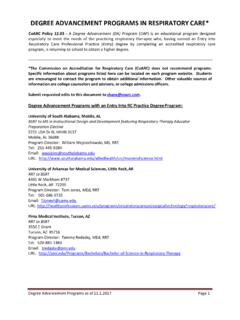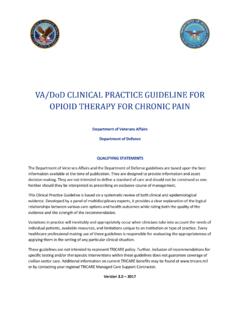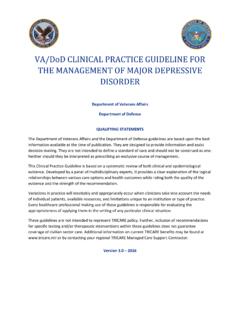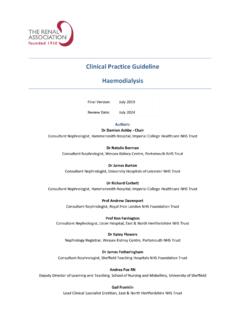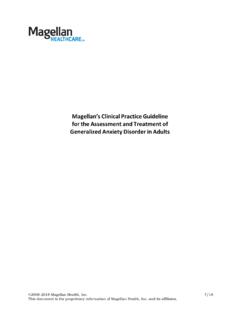Transcription of AARC Clinical Practice Guideline: Effectiveness of ...
1 AARC Clinical Practice Guideline: Effectivenessof Nonpharmacologic Airway Clearance Therapiesin Hospitalized PatientsShawna L Strickland PhD RRT-NPS AE-C FAARC, Bruce K Rubin MD MEngr MBA FAARC,Gail S Drescher MA RRT, Carl F Haas MLS RRT FAARC, Catherine A O Malley RRT-NPS,Teresa A Volsko MHHS RRT FAARC, Richard D Branson MSc RRT FAARC,and Dean R Hess PhD RRT FAARCA irway clearance therapy (ACT) is used in a variety of settings for a variety of ailments. Theseguidelines were developed from a systematic review with the purpose of determining whether theuse of nonpharmacologic ACT improves oxygenation, reduces length of time on the ventilator,reduces stay in the ICU, resolves atelectasis/consolidation, and/or improves respiratory mechanics,versus usual care in 3 populations.
2 For hospitalized, adult and pediatric patients without cysticfibrosis, 1) chest physiotherapy (CPT) is not recommended for the routine treatment of uncompli-cated pneumonia; 2) ACT is not recommended for routine use in patients with COPD; 3) ACT maybe considered in patients with COPD with symptomatic secretion retention, guided by patientpreference, toleration, and Effectiveness of therapy; 4) ACT is not recommended if the patient isable to mobilize secretions with cough, but instruction in effective cough technique may be adult and pediatric patients with neuromuscular disease, respiratory muscle weakness, orimpaired cough, 1) cough assist techniques should be used in patients with neuromuscular disease,particularly when peak cough flow is<270 L/min; CPT, positive expiratory pressure, intrapul-monary percussive ventilation, and high-frequency chest wall compression cannot be recommended,due to insufficient evidence.
3 For postoperative adult and pediatric patients, 1) incentive spirometryis not recommended for routine, prophylactic use in postoperative patients, 2) early mobility andambulation is recommended to reduce postoperative complications and promote airway clearance,3) ACT is not recommended for routine postoperative care. The lack of available high-level evi-dence related to ACT should prompt the design and completion of properly designed studies todetermine the appropriate role for these words: airway clearance therapy; ACT; chestphysiotherapy; CPT; atelectasis; secretion clearance; percussion.[Respir Care 2013;58(12):2187 2193. 2013 Daedalus Enterprises]Dr Strickland is affiliated with the American Association for RespiratoryCare, Irving, Texas. Dr Rubin is affiliated with the Children s Hospital ofRichmond at Virginia Commonwealth University, Richmond, Drescher is affiliated with the Washington Hospital Center, Wash-ington DC.
4 Mr Haas is affiliated with the University of Michigan HealthSystem, Ann Arbor, Michigan. Ms O Malley is affiliated with the Annand Robert H Lurie Children s Hospital of Chicago, Chicago, Volsko is affiliated with Akron Children s Hospital, Akron, Branson is affiliated with the University of Cincinnati Collegeof Medicine, Cincinnati, Ohio. Dr Hess is affiliated with MassachusettsGeneral Hospital, Harvard Medical School, Boston, Rubin has disclosed relationships with GlaxoSmithKline, Pfizer,InspiRx, Fisher & Paykel, Teleflex, Philips Respironics, Novartis,Electromed, and Salter Labs. Ms O Malley has disclosed relationshipswith Novartis and Pari Respiratory Equipment. Mr Branson has disclosedrelationships with Covidien, Hamilton Medical, Advanced CirculatorySystems, Ikaria, Bayer, and Breathe Technologies.
5 Dr Hess has disclosedrelationships with Philips Respironics, Pari Respiratory Equipment,Covidien, Maquet, and Merck. The other authors have disclosed no con-flicts of : Shawna L Strickland PhD RRT-NPS AE-C FAARC,American Association for Respiratory Care, 9425 N MacArthur Boule-vard, Suite 100, Irving TX 75063. E-mail: DECEMBER2013 VOL58 NO122187 IntroductionThe mucociliary escalator and cough reflex defend therespiratory system by facilitating secretion clearance andpreventing airways obstruction. Healthy individuals pro-duce 10 100 mL1of airway secretions daily, which arecleared by the centripetal movement of the factors make it difficult to mobilize andevacuate secretions. The efficacy of the mucociliary esca-lator is impaired by aging, tobacco use, environmentalexposures, and disorders such as conditions decrease the ability to cough ef-fectively, leading to secretion clearance therapy (ACT)
6 , performed by respi-ratory therapists and other healthcare providers, is intendedto aid secretion mobilization and expectoration, and tomitigate complications associated with secretion uses physical or mechanical means to manipulate airflow, to mobilize secretions cephalad, and to facilitate evac-uation by maneuvers, gravity as-sisted drainage, manual techniques, and mechanical de-vices can be used in an effort to facilitate , performing, and educating patients andfamilies on ACT and secretion management are within therespiratory therapist s scope of Practice . This therapy isalso within the Practice of physical therapists, nurses, andothers. When possible, therapy should be matched to thepatient s disease process, cognitive ability and preferences,the characteristics and limitations of the device or tech-nique, and cost.
7 Clinicians prescribing this therapy andthose implementing the therapy must be familiar with theevidence supporting ACT techniques and devices, whichis often ,13 The purpose of this guideline, developed in conjunctionwith the systematic review by Andrews et al,14is to pro-vide guidance to clinicians in the identification, selection,and application of ACT techniques. These guidelines donot include the use of ACT in patients with cystic fibrosis(CF), as this has already been of EvidenceWe sought to determine whether the use of nonpharma-cologic ACT improves oxygenation, reduces length oftime on the ventilator, reduces stay in the ICU, resolvesatelectasis/consolidation, and/or improves respiratory me-chanics versus usual care in 3 populations. The ACTsconsidered are listed in the Table.
8 Because no high-levelevidence was available and the recommendations are basedon low-level evidence, we have not used a formal guide-line development process such as the Grading of Recom-mendations Assessment, Development, and Evaluation(GRADE) ,therecommendationsarebasedon a consensus of the committee, informed by a systematicreview of the literature14and Clinical experience. The sys-tematic review helped frame the issues and allowed for anidentification of potential Adult and Pediatric PatientsWithout Cystic FibrosisDiseases such as pneumonia, bronchiectasis, COPD, andasthma have the potential to increase airway secretions,and endotracheal intubation can impair secretion clear-ance. Some patients are prescribed ACT for prophylaxisagainst symptomatic secretion retention (ie, ineffective gasexchange, atelectasis, dyspnea).
9 Because of its historicalprominence and frequent use, chest physiotherapy (CPT)has mistakenly been classified as the gold standard systematic review found no evidence from ran-domized controlled trials (RCTs) to support the use ofACTs to improve oxygenation, reduce length of time onTable. Airway Clearance Therapies Included in the systematic ReviewAirway Clearance TherapyAcronymDefinitionActive cycle of breathing techniqueACBTD irected cough technique; relaxed diaphragmatic breathing and deep breathingcycles followed by forced exhalation techniqueChest physiotherapyCPTE xternal chest wall manipulation, which includes one of, a combination of, orall of: percussion, vibration, and postural drainage therapyForced exhalation techniqueFETD irected open-glottis cough technique.
10 Also called huffingHigh-frequency chest wall compressionHFCWCE xternal manipulation through a vest or wrap worn by the patient, which isconnected to a device using bursts of air to compress the chest wallIntrapulmonary percussive ventilationIPVP neumatically powered, high-frequency short bursts of gas applied at the airwayopening (ie, mask encircling the nose and mouth, mouth, or tracheostomy tube)Mechanical insufflation-exsufflation(none)Mechanica lly applied positive-pressure breath, followed by negative pressureapplied to the airway openingPositive expiratory pressurePEPE xhalation against a fixed resistor that creates an increase in airway pressure;includes oscillatory PEP devices such as Flutter and AcapellaAARC CPG: Effectiveness OFNONPHARMACOLOGICAIRWAYCLEARANCETHERAPI ES INHOSPITALIZEDPATIENTS2188 RESPIRATORYCARE DECEMBER2013 VOL58 NO12the ventilator, reduce stay in the ICU, resolve atelectasis/consolidation, and/or improve respiratory mechanics ver-sus usual care in this studies suggestthat intrapulmonary percussive ventilation (IPV) may de-crease stay in the ICU for non-intubated patients withCOPD, but insufficient high-level evidence exists to sup-port a recommendation for this ,20 guidelines from other groups also identified minimalevidence to support the use of ACT in hospitalized ,22 Based on lower levels of evidence, some guide-lines recommend forced expiratory technique (FET) forCOPD patients,21active cycle of breathing technique(ACBT)

